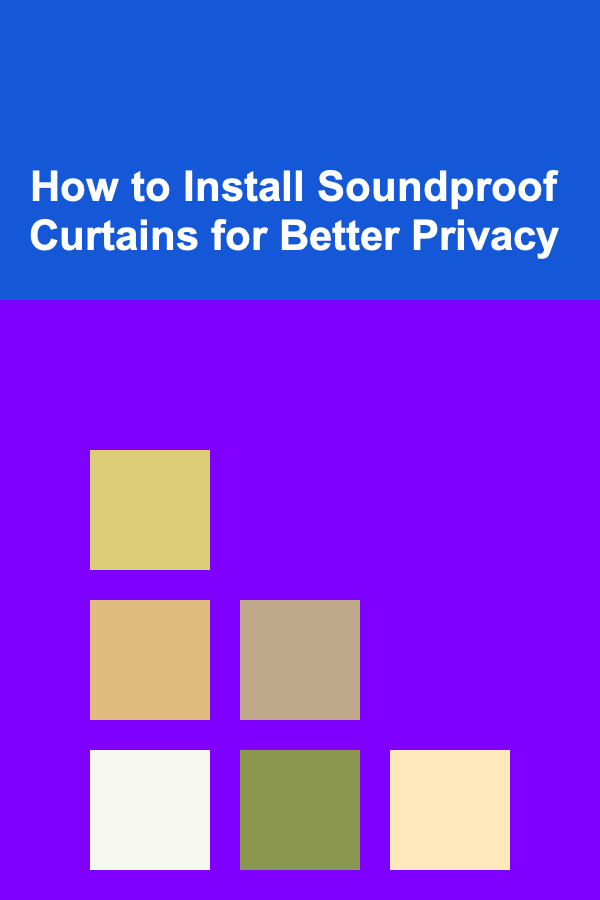
How to Start a Freelance Graphic Design Business from Home: An Actionable Guide
ebook include PDF & Audio bundle (Micro Guide)
$12.99$8.99
Limited Time Offer! Order within the next:

Starting a freelance graphic design business from home is an exciting and rewarding venture. With the rise of remote work and the increasing demand for digital design, this is the perfect time to capitalize on your creative skills. Whether you're a seasoned graphic designer or just starting, this guide will help you navigate the essential steps to building a successful freelance graphic design business from the comfort of your own home.
Understand the Freelance Graphic Design Industry
Before diving into the technicalities of setting up your business, it's important to understand the landscape of the graphic design industry. Freelancing, especially in creative fields, has seen a massive surge in recent years. Businesses of all sizes need graphic design for branding, advertising, websites, and social media content, and many are opting to hire freelancers for flexibility and cost-effectiveness.
Market Demand for Graphic Design Services
The demand for graphic design services is diverse and spans across various sectors:
- Branding and Identity: Logos, color schemes, and visual identities for new businesses or rebranding existing companies.
- Web and Mobile Design: Designing websites, apps, and user interfaces that are visually appealing and user-friendly.
- Marketing Materials: Brochures, flyers, posters, and digital advertisements.
- Social Media Graphics: Designs for social media platforms like Instagram, Facebook, and Twitter.
- Packaging Design: For products in the retail or e-commerce space.
Understanding this landscape will help you decide what niche you want to specialize in, allowing you to tailor your offerings to meet market needs effectively.
Develop and Refine Your Skills
To succeed as a freelance graphic designer, your technical and creative skills need to be on point. This means having a strong grasp of design principles, as well as proficiency in the tools of the trade.
Essential Design Skills
- Design Theory: Understand the principles of design, such as composition, color theory, typography, and visual hierarchy. These are foundational to creating effective and aesthetically pleasing designs.
- Adobe Creative Suite: Mastery of tools like Adobe Illustrator, Photoshop, and InDesign is often essential for most design projects.
- Web Design: Familiarize yourself with web design principles, especially responsive design and user experience (UX) practices. Learning basic coding (HTML, CSS) can also be helpful for certain projects.
- UI/UX Design: User interface and experience design are increasingly important, especially for projects that involve web or app design.
- Communication and Collaboration: Freelancers need strong communication skills, as they will often work directly with clients to understand their vision and collaborate with other professionals (e.g., developers, marketers).
Continuous Learning
The design world is constantly evolving, with new tools, trends, and technologies emerging all the time. It's important to stay current by:
- Taking online courses on platforms like Skillshare, Udemy, or Coursera.
- Participating in design communities on Behance, Dribbble, or Reddit to get feedback and stay inspired.
- Attending design conferences or webinars to learn from industry experts and network with others.
Define Your Niche and Offerings
Freelance graphic design is a broad field, so specializing in a niche can make you stand out. When starting your freelance business, ask yourself:
- What type of design do I enjoy the most?
- What industries or clients do I want to work with?
- What skills do I have that differentiate me from others?
Some potential niches within graphic design include:
- Branding and Identity Design: Focus on creating logos, business cards, and brand guidelines.
- Website and Mobile Design: Specialize in designing websites, landing pages, and apps.
- Social Media and Content Design: Create custom graphics for social media posts, infographics, and ads.
- Packaging and Product Design: Focus on designing packaging for products or creating product mockups.
- Illustration and Custom Artwork: Offer custom illustrations or graphic art for clients who need unique visuals.
By defining your niche, you can tailor your portfolio, marketing, and client outreach, making it easier to attract the right clients who value your expertise.
Set Up Your Freelance Graphic Design Business
Now that you've got your skills and niche sorted, it's time to set up the business side of your freelance graphic design career.
Legal Structure and Business Registration
While freelancing allows flexibility, it's still important to set up your business correctly. Depending on your location, you may need to:
- Register as a Sole Proprietor: In many cases, freelancers operate as sole proprietors, which is the simplest form of business structure.
- Obtain an LLC: If you want more protection for your personal assets, consider forming a Limited Liability Company (LLC).
- Get a Business License: Some areas require you to obtain a business license, even for freelancers.
Check with your local government to ensure you are complying with any legal requirements for operating as a freelancer.
Set Your Rates
As a freelance graphic designer, one of the trickiest parts of the business is determining how much to charge. Your rates will depend on several factors, including your experience, the complexity of the work, and the industry you're working in.
- Hourly Rate vs. Project Rate: Decide whether you want to charge hourly or per project. Many designers find it easier to quote flat rates for specific projects.
- Market Research: Look at what other freelancers in your niche are charging. Websites like Glassdoor or Payscale can give you insight into average rates.
- Value-Based Pricing: Instead of just considering the hours worked, think about the value your design brings to the client's business. For example, a logo for a new brand may have a significant impact on the business's success, so you can price accordingly.
Build a Portfolio
Your portfolio is your primary marketing tool as a freelancer. Potential clients will want to see examples of your work before hiring you. Here's how to build a standout portfolio:
- Showcase Your Best Work: Curate a selection of projects that highlight your skills and expertise. Quality is more important than quantity.
- Include Personal Projects: If you're just starting, include personal design projects or mock-ups to show your abilities.
- Create a Website: Build a professional website to host your portfolio, and include a section for client testimonials, case studies, and a clear list of services.
- Use Platforms like Behance: Behance is a great platform for graphic designers to showcase their work and attract potential clients.
Find Clients and Market Your Services
Now that you have your business set up, it's time to attract clients. Freelancers need to be proactive when it comes to marketing their services.
Networking
Building relationships is essential for freelance success. Networking can help you gain new clients, learn from others, and grow your business.
- Attend Industry Events: Whether virtual or in-person, industry events like design conferences and meetups can help you connect with potential clients and collaborators.
- Join Online Communities: Participate in online communities such as LinkedIn, Facebook groups, and forums like Designer Hangout or Designer News.
- Collaborate with Other Freelancers: Partner with web developers, marketers, or writers to offer full-service packages to clients.
Use Freelance Platforms
There are many online platforms where you can find freelance design gigs. Some popular ones include:
- Upwork: A marketplace for freelance jobs across various industries.
- Fiverr: Great for small projects and one-time gigs, Fiverr allows you to create "packages" of services.
- 99designs: A platform specifically for designers, where you can participate in design contests or be hired for one-on-one projects.
- Dribbble: A community of designers where you can showcase your work and attract potential clients.
Digital Marketing
To increase visibility and attract clients, make use of digital marketing strategies such as:
- Social Media Marketing: Use platforms like Instagram, Pinterest, and LinkedIn to showcase your work, connect with potential clients, and share behind-the-scenes content.
- SEO for Your Website: Optimize your website for search engines so potential clients can find you online. Use keywords related to your services and niche.
- Email Marketing: Create an email list to stay in touch with past clients and potential leads. Share valuable content, updates on new services, or promotions.
Manage Your Freelance Business Efficiently
To maintain a successful freelance business, efficient management is crucial. You'll need to handle finances, client communication, project management, and deadlines.
Set Up Financial Systems
- Invoicing and Payments: Use tools like QuickBooks, FreshBooks, or Stripe to send professional invoices and track payments.
- Taxes: As a freelancer, you're responsible for your own taxes. Set aside a percentage of your earnings for taxes, and consider hiring an accountant or using software to help manage your finances.
- Budgeting: Track your income and expenses to ensure you're staying within your budget. Plan for lean months, especially early on.
Manage Projects and Clients
- Communication Tools: Use tools like Slack or Zoom to communicate effectively with clients and teams.
- Project Management Tools : Tools like Trello, Asana, or Monday.com can help you keep track of deadlines, client requests, and project progress.
- Client Contracts: Always use a contract to outline the scope of the project, deadlines, payment terms, and any other important details to avoid misunderstandings.
Scale Your Business
As you gain more clients and experience, you may want to scale your freelance business. This can be achieved by:
- Raising Your Rates: As you gain expertise, you can increase your rates to reflect your higher skill level and reputation.
- Outsourcing Work: If you're overwhelmed with projects, consider outsourcing work to other designers. This allows you to take on more clients without compromising on quality.
- Diversifying Services: Offer complementary services like branding consultation or design strategy to increase your income streams.
Final Thoughts
Starting a freelance graphic design business from home requires a combination of creativity, technical skills, business acumen, and effective marketing. By following this actionable guide, you can establish a solid foundation for your freelance career, attract clients, and manage your business efficiently. With persistence, the right skills, and a well-thought-out strategy, you can turn your passion for design into a thriving freelance business.
Reading More From Our Other Websites
- [Personal Care Tips 101] How to Choose the Best Lip Balm for Your Skin Type
- [Home Staging 101] How to Stage Your Home for a Family-Friendly Vibe
- [Home Rental Property 101] How to Offer Incentives to Attract Quality Tenants
- [Home Budget Decorating 101] How to Decorate Your Home with Cheap but Elegant Accessories
- [Organization Tip 101] How to Create a Designated Space for Stain Removal
- [Home Staging 101] How to Stage a Home with a Home Office to Appeal to Remote Workers
- [Needle Felting Tip 101] Best Approaches to Teaching Needle Felting to Children with Sensory Processing Challenges
- [Home Cleaning 101] How to Organize and Clean Your Office Space at Home
- [Screen Printing Tip 101] Must-Have Tools for Affordable Home Screen-Printing Setups
- [Organization Tip 101] The Best Outdoor Kitchen Layouts for Small and Large Spaces

How to Budget for Sustainable and Eco-Friendly Home Choices
Read More
How to Install Soundproof Curtains for Better Privacy
Read More
How to Optimize Your Closet for Seasonal Wardrobe Changes
Read More
How To Craft Powerful Themes in Your Writing
Read More
How to Interpret Radar Imagery for Severe Weather
Read More
10 Mistakes Data Science Consultants Make (and How to Avoid Them)
Read MoreOther Products

How to Budget for Sustainable and Eco-Friendly Home Choices
Read More
How to Install Soundproof Curtains for Better Privacy
Read More
How to Optimize Your Closet for Seasonal Wardrobe Changes
Read More
How To Craft Powerful Themes in Your Writing
Read More
How to Interpret Radar Imagery for Severe Weather
Read More